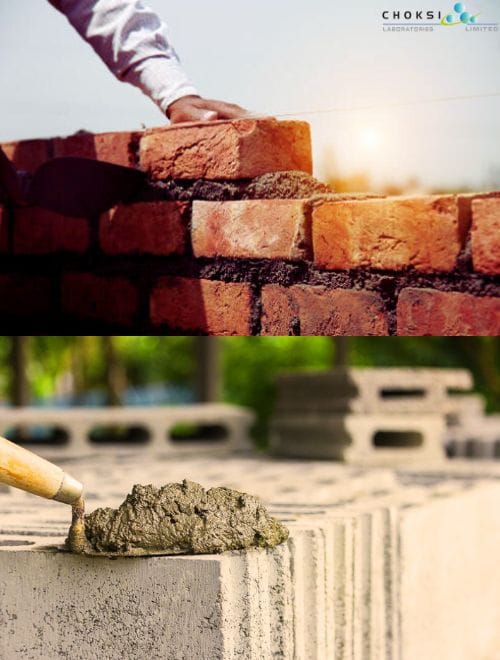Home» Construction Material Analysis» Building Material
Building Material
Building material testing involves assessing the physical and mechanical properties of construction materials like concrete, steel, and asphalt to ensure they meet quality standards. This process includes evaluating factors such as strength, durability, and composition through various laboratory tests. The results guide construction professionals in ensuring the materials perform effectively in their intended applications.
Cement is a fine powder made from a mixture of limestone, clay, and other minerals, which, when mixed with water, forms a paste that hardens and binds together inert aggregates like sand and gravel. It is a crucial building material used in construction for creating concrete and mortar, providing strength and durability to structures.
Fly ash is a fine powder residue generated from burning pulverized coal in power plants. It is commonly used as a supplementary cementitious material in concrete to enhance strength and reduce environmental impact.
Aggregate refers to a granular material, such as sand, gravel, crushed stone, or recycled concrete, used in construction. It is combined with cement to form concrete, providing bulk, stability, and strength to the mixture.
Cement-based white polymeric putty is a construction material used for smoothing and finishing walls. It consists of a blend of cement, white polymers, and additives, providing a durable, water-resistant coating with a smooth, aesthetically pleasing finish.
Paver blocks are concrete or brick units used in pavement construction, featuring interlocking designs for easy installation. These durable and versatile blocks are commonly employed in driveways, walkways, and patios to create stable and visually appealing surfaces.
AAC (Autoclaved Aerated Concrete) blocks are lightweight, precast concrete building blocks with excellent thermal insulation properties, created through a process of autoclaving aerated concrete mixtures. Widely used in construction, AAC blocks offer advantages such as energy efficiency, fire resistance, and ease of handling.
Bricks are rectangular building blocks typically made of clay or concrete, used in construction for creating walls, pavements, and other structures. They are hardened through firing (in the case of clay bricks) or curing (for concrete bricks) to provide strength and durability.
Structural steel is a high-strength metal alloy primarily used in construction for framing and supporting buildings, bridges, and other structures due to its durability and load-bearing capacity. Its composition includes iron and varying amounts of carbon and other alloying elements.
High Strength Deformed (HSD) Steel Bars and Wires for Concrete Reinforcement are specially designed construction materials with enhanced strength and deformability. These bars and wires are crucial components in reinforced concrete structures, providing structural integrity and durability.

Types of tests performed in CLL lab
| Cement | Cement based white polymeric putty | Structural steel | Flyash |
|---|---|---|---|
| Standard Consistency | Tensile adhesion strength | Dimensions | Fineness-specific surface in m2/kg by Blaine’s permeability method. |
| Fineness by Blaine | Water retentivity | Yield Stress | Particles retained on 45 micron IS sieve (wet sieving) |
| Setting time Initial & Final | Polymer content | Tensile Strength | Lime reactivity |
| Soundness by autoclave and le-chatter | Degree of whiteness | Elongation at break | Compressive strength at 28 days |
| Compressive strength | Cement content | Bend test/Charpy impact | Soundness by autoclave test |
| Drying shrinkage | Compressive strength, 28 days | Chemical composition | Chemical composition |
| Aggregate | Paver block | HSDS Bars | AAC block/Bricks |
|---|---|---|---|
| Deleterious Materials | Visual Inspection | Dimensions | Dimensions |
| Aggregate Crushing Value | Dimensions and Tolerances | Yield Stress | Water absorption |
| Aggregates Impact Value | Water Absorption | Tensile Strength | Water absorption of rock |
| Aggregate Abrasion Value | Thickness of Wearing Layer | Elongation at break | Compressive Strength |
| Soundness of Aggregate | Compressive Strength | Bend test | Drying Shrinkage |
| Particle size analysis | Abrasion Resistance | Charpy impact | Effloresce |
| Coal and lignite | Tensile Splitting Strength | chemical composition | Moisture Movement |
| Material finer then 75 micron | Flexural Strength/Breaking Load | Pullout test | - |
| Clay lumps/Shale | Freeze-Thaw Curability | Rebind | - |
| Soft fragment | Color and Texture | - | - |
